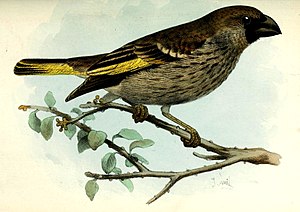Socotragimpel
| Socotragimpel | ||||||||||||
|---|---|---|---|---|---|---|---|---|---|---|---|---|

Socotragimpel in youth dress |
||||||||||||
| Systematics | ||||||||||||
|
||||||||||||
| Scientific name | ||||||||||||
| Rhynchostruthus socotranus | ||||||||||||
| Sclater & Hartlaub , 1881 |
The Socotragimpel ( Rhynchostruthus socotranus ) is a songbird species from the finch family . The species occurs exclusively on the island of Socotra south of the Arabian Peninsula . So far, the species has been listed as the only one of the genus Rhynchostruthus , but for some time the forms Arabian bullfinch and Somali bullfinch, which were previously listed as subspecies, have been considered separate species. In contrast to these, the IUCN classifies the Sociotragimpel as not endangered (“least concern”). The distribution area of the Socotragimpel is very small at 3,600 square kilometers, but the population, which is estimated at 6,500 individuals, seems to be stable.
description
The approximately 14.5 cm long Socotragimpel is a large-headed, short-tailed and robustly built finch with a very strong beak, which is high at the base and black to dark slate-gray. The wing length is between 83 and 87 mm. The feet and legs are flesh-colored. A sexual dimorphism is pronounced only small, the sexes are in the field but well distinguished from each other.
In the male, the head is dark brown up to the upper edge of the neck, darker to the forehead, face area and down to the throat, up to black. The ear covers stand out clearly white and are completely surrounded by the dark area, but sometimes only delimited by a narrow strip downwards. The body plumage is predominantly beige-brown, somewhat darker on the upper side and simply gray on the rump and upper tail- coverts. The shoulder feathers are colored like the upper side, the middle armcovers gray to dark gray with bright yellow tips. The yellow color is also found on the large arm covers and the outer flags of the arm wings . In the former, only the inner ones are black, tipped with beige and have a gray border; in the latter, the inner flag and tip are black. The entire hand wing and the umbrella springs are black, only the innermost umbrella spring has a yellow border on the outer flag. The thrust is short and notched at the end, brown to blackish and, apart from the inner pair on the outer flags, broadly yellow, so that yellow fields result on the outside of the tail. The under tail-coverts are white.
The female differs from the male in that the areas on the head are less deep black, the color is more brown, the ear covers are grayish white. The upper side is less dark and has a brownish wash, a brownish-washed tone can also be found on the upper chest and the belly is grayer in some specimens. The tail sides are less extensive yellow.
Birds in youthful plumage are strongly dashed and overall darker brownish. The dark head area is missing and the ear covers, which are white in adult birds, are at best a yellowish beige base. The yellow of the wings and the control feathers is less intense and limited to the hems and tips. The beak is lightened gray at the base of the lower mandible.
voice
The vocal repertoire of the Socotragimpel is similar to that of the goldfinch . Typical calls are wip , wink or tsie , a sequence of deeds , tat, tat or did-ie , a soft tlijit , which is also often arranged, or a quick sequence of di di di calls that ends with a rough trill. The singing is flowing and melodic. It is often performed from a control room hidden in the branches or from a bat-like singing flight and is described as wiet wi-o like or similar.
Distribution and way of life
The Socotra pimple occurs exclusively on Socotra . It inhabits a wide range of habitats on this archipelago and occurs from the lowlands to the high plateau. The typical habitat is dry bush and forest areas with vegetation dominated by milkweed , acacia and juniper . The fruits and seeds of these species represent the main food of the Socotragimpel.
Systematics
Until recently, the Socotragimpel ( Rhynchostruthus socotranus ), the Arabian bullfinch ( Rh. Percivali ) native to the south of the Arabian Peninsula and the Somali finch ( Rh. Louisae ) found in Somalia were regarded as subspecies of the "golden winged bullfinch" and the genus Rhynchostruthus as a monotype . In 2004 C. Hilary Fry and Stuart Keith proposed a breakdown of the African subspecies Rh. Socotranus louisae . Guy M. Kirwan and Andrew Grieve contradicted this in 2007 insofar as either all three forms were to be regarded as allospecies or continue to be considered subspecies, but a breakdown of only one of the three forms could not be justified due to numerous morphological characteristics. They suggested a species status for all three taxa . Today this view is widespread consensus, BirdLife International and the IUCN have already followed the recommendation, although - as Kirwan and Grieve emphasize - molecular genetic confirmation is still pending.
supporting documents
literature
- P. Clement, A. Harris, J. Davis: Finches and Sparrows , Helm Identification Guides, London 1993/1999, ISBN 0-7136-5203-9
- Kirwan, GM & Grieve, A. (2007): Studies of Socotran birds II. One, two or three species: towards a rational taxonomy for the Golden-winged Grosbeak Rhynchostruthus socotranus . Bulletin of the African Bird Club, 14 (2), pp. 159-169.
- Horst Bielfeld : siskins, giraffe, bullfinches and grosbeak. Verlag Eugen Ulmer, Stuttgart 2003, ISBN 3-8001-3675-9 .
Web links
- Rhynchostruthus socotranus in the endangered Red List species the IUCN 2009. Posted by: BirdLife International, 2009. Retrieved on February 2, 2011th
- BirdLife Factsheet , accessed February 2, 2011
- Videos, photos and sound recordings for Rhynchostruthus socotranus in the Internet Bird Collection
- Photos of the Socotra Impulse , accessed February 2, 2011